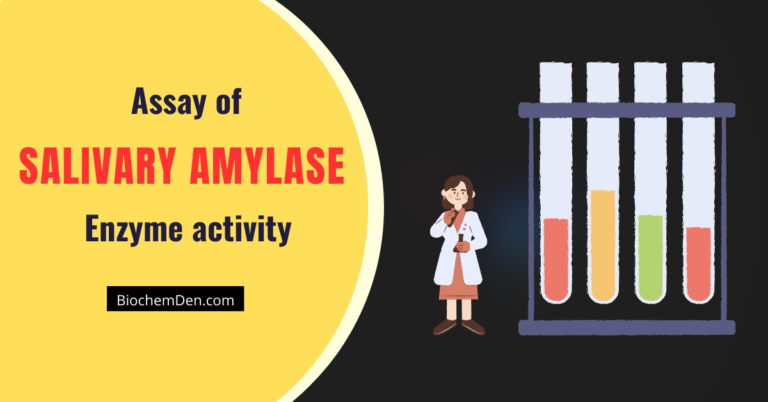There is no standard assay for acid phosphatase enzyme activity in potatoes. However, one common assay procedure involves measuring the amount of phosphate released from a substrate following incubation with the enzyme. There are also commercial kits for this purpose.
Another assay procedure involves measuring the decrease in medium phosphate concentration when potato cells have been lysed following incubation with enzyme, e.g., by adding dithiothreitol and samples must be collected at intervals of 1-2 hours during which time a steady state is reached causing increased sensitivity (see below).
The latter method appears to be much more highly sensitive but has not generally found favor with workers in the field.
This is the enzymology protocol for the “Assay of Acid Phosphatase Enzyme Activity from Potatoes”. Before going to the protocol, we should know a few points about the phosphatase enzyme.
- A phosphatase is an enzyme that removes a phosphate group from its substrate by hydrolyzing phosphoric acid monoesters into a phosphate ion and a molecule with a free hydroxyl group.
- This action is directly opposite to that of phosphorylases and kinases, which attach phosphate groups to their substrates by using energetic molecules like ATP.
- A common phosphatase in many organisms is alkaline phosphatase.
- Protein phosphorylation is a common post-translational modification of protein catalyzed by protein kinases, and protein phosphatases reverse the effect.
Assay of Acid Phosphatase enzyme activity from Potatoes
Aim:
To determine the acid phosphatase enzyme activity in potatoes using Sodium-β-Glycerophosphate as Substrate
Principle:
Phosphatases liberate inorganic phosphate from organic phosphate ester. Acid phosphatase hydrolases, a number of phosphomonoesters, and phosphor proteins. Acid phosphatases can be assayed by measuring the amount of inorganic phosphorus released from Sodium-β-Glycerophosphate. The phosphorous released is estimated by the Fiske Subbarao method.
Reagents
- Citrate buffer (pH 5.6):
- 1M Citric acid: Dissolve 5.25 gms of citric acid in distilled water and make up to 250 ml with distilled water.
- 1M trisodium citrate: Dissolve 14.7 gms of trisodium citrate in distilled water and make it up to 500ml. Mix 137ml of citric acid with 363ml of trisodium citrate solution and set up pH 5.6 buffer solutions. (0.02M Sodium-β-Glycerophosphate in citrate buffer.)
- 10% TCA (Tri Chloroacetic acid): Dissolve 10 grams of TCA in 100 ml distilled water.
Enzyme Extract
Clean and wash the potatoes with distilled water and peel off the skin. Weigh about 200g using a rough balance. Cut it into small pieces, then add 200ml of ice-cold distilled water and homogenize it in a grinder. Filter the homogenate using a cloth and store the filtrate in a refrigerator.
Procedure
Take 5ml of buffer substrate, clean and dry the test tube, then preincubate for 30 minutes at 370C. At the end of the incubation period, add 2.5 ml of 10% TCA and mix well. Keep the test tubes for another minute at room temperature and filter the contents. Take 1ml of the filtrate for the denaturation of inorganic phosphorous by the Fiske-Subbarao method.
Set up a control simultaneously by adding ml of TCA to 5 ml of buffer substrate followed by ml of enzyme and proceeds as per test.
To determine the protein content of the enzyme extract by the biuret method. For this experiment, take 1 ml of extract, add 1 ml of water, add 3 ml of biuret reagent and follow the procedure as per the biuret estimation procedure.
Report
The amount of inorganic phosphorous present in the given unknown sample is ______ mg of inorganic phosphate formed per 1 ml of enzyme for 30 minutes.
Frequently Asked Questions (FAQs)
What is the assay for acid phosphatase enzyme activity in potatoes?
The assay for acid phosphatase enzyme activity in potatoes is the most common assay used to measure the enzymatic activity of potato cells. The acid phosphatase enzyme catalyzes the hydrolysis of phosphate esters to their phosphate ions and water molecules. The activity of the acid phosphatase enzyme can be measured by measuring the amount of phosphate released over a specific time period.
What is the method for determining acid phosphatase enzyme activity in potatoes?
The method for determining acid phosphatase enzyme activity in potatoes is to extract the enzyme using a precipitation method, then measure the absorbance at 600 nm. The higher the activity of the acid phosphatase, the more blue color will be present in the reaction mixture.
How much would a potato have to be cooked before measuring its tomato powder hydrolyzing activity?
A potato would need to be cooked until it is soft, so the starch in the potato will have been broken down into sugar and other carbohydrates. The tomato powder hydrolyzing activity would then be measured after the potato has been cooked for a specific amount of time.
How does one assay for acid phosphatase enzyme activity from potatoes?
Potatoes can be analyzed for the presence of acid phosphatase enzyme activity by adding 0.1 milliliters (ml) of a phosphate buffer solution (PBS) containing 0.2% hydrogen phosphate to 1 liter (1 qt) of ground potatoes and incubating at 37 °C for 18 hours. The potato enzyme activity will be quantified using an enzymatic assay kit.
What substances can be used to assay acid phosphatase enzyme activity from potatoes?
A number of substances can be used to assay the acid phosphatase enzyme activity of potatoes. One approach would be to measure the activity of an acid phosphatase enzyme immobilized on a membrane or bead. Other substances that can be used for this purpose include p-nitrophenyl phosphate and Myo-inositol triphosphate.
Can acidic foods interfere with the analysis of acid phosphatase enzyme activity from potatoes?
There is no definitive answer to whether acidic foods will interfere with the analysis of acid phosphatase enzyme activity from potatoes. It is advised that caution be used when handling these types of samples and that any modifications to the assay protocol be outlined in the laboratory documentation.
What are some common potato cultivars that have good acid phosphatase enzyme activity within the scope of this experiment?
Some common potato cultivars that have good acid phosphatase enzyme activity within the scope of this experiment include Russet Burbank, Idaho 842, and Red Bliss.
What are the disadvantages associated with analyzing potato tubers for acid phophatase enzyme activity from potatoes?
There are many disadvantages associated with analyzing potato tubers for acid phophatase enzyme activity from potatoes. The most significant disadvantage is the low level of acid phophatase enzyme activity found in most potato tubers. This means that it is difficult to determine whether a particular potato tuber contains acid phophatase enzyme activity. Additionally, potato tubers can be small and difficult to extract the enzyme from.
Few other Protocols
- Effect of Temperature on Amylase activity
- Isolation of Glycogen from Liver
- Estimation of Pyruvate by using 2,4 DNP
- Effect of Enzyme Concentration on Alpha-Amylase Activity
- Isolation of Starch from Potatoes
- Estimation of Saponification Value of Fats/Oils
- Time Course of Enzyme Activity (Alpha-Amylase)
- Effect of Substrate Concentration on Alpha-Amylase Activity
- Effect of pH on enzyme activity and determination of optimum pH
- Estimation of Tyrosine by the “FC Method”
- Estimation of Proteins by “Lowry method”
- Estimation of Protein by the Bradford Method






